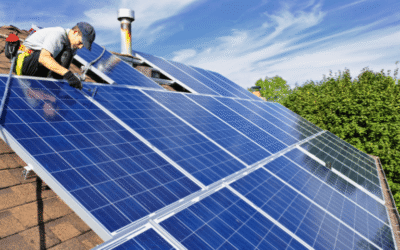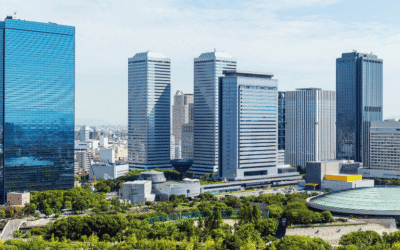We’ll take a look at the popular warehouse lighting fixtures so you can choose the products best suited for your space.
Warehouse Light Fixtures
The right warehouse lighting fixtures can increase employee productivity and safety. Here are six common types and examples of where to use each type of lighting fixture.
High Bay Lights
High bays work best in areas with high ceilings, typically 20 to 35 feet in height. Pay attention to ceiling height. Higher ceilings need fixtures with a high lumens output to adequately illuminate the space.
There are two common types of high bay lights,
- Round High Bay Lights: Feature a wide beam spread to cover a large area with light, making them great for increasing visibility in open areas. They only have one contact point, so they are easier to install than linear lights.
- Linear High Bay Lights: Feature a more compact, rectangular light distribution to help illuminate specific aisles and shelving areas. They can typically be surface-, suspended-, or pendant-mounted.
The best places to use high bays are in large buildings, manufacturing plants, amphitheaters, and airport hangers.
Standard high bay light sizes typically measure 10″ to 13″ in diameter (round) or 2′, 4′, or 8′ in length (linear).
Interested in learning more about High Bay or Low Bay lighting? We have an entire page dedicated to high bay lighting in our Lighting and LED Product Education Center. We cover benefits, concerns, efficiencies and so much more. To read, What is High Bay and Low Bay Lighting, click here.
Tube Lights
Tube lights are a great option in warehouses with ceilings measuring 8 to 10 ft in height. This type of warehouse lighting illuminates a specific area, instead of a large space.
You can choose from the following four types of tube lighting,
- Type A Tubes: Works with the existing ballast.
- Type B Tubes: Works by bypassing the ballast.
- Type AB Tubes: Works with or without the ballast.
- Type C Tubes: Works with an external driver.
Tube lights are a good choice in breakrooms, warehouse offices, and storage areas.
You can find tube lights in the following sizes: 2′, 4′, or 8′ in length.
Wall Pack Lights
Wall pack lights are typically mounted to exterior building walls. The box-shaped warehouse lighting fixtures provide lighting in parking lots and along walkways and entryways. Here’s a quick look at three common types of wall pack lights.
- Traditional Wall Pack Lights: Feature an open design and a wider lens to deliver a wider beam spread. They are particularly great for entryways where extra light is needed for safety and security.
- Full Cut-Off Wall Pack Lights: Direct light distribution downward to eliminate all uplight illumination. They are dark sky compliant and prevent light pollution.
- Slim Wall Pack: Feature an adjustable beam angle for greater versatility with light projection.
Utility sheds, loading docks, walkways, and storage areas are great places to use the warehouse lighting fixtures.
Wall lights typically come in sizes ranging from 6″ to 18″ in length, depending on the style.
Commercial Panel Lights
Commercial panel lights have a low profile. The flat light fixtures are often surface or recessed-mounted. The fixtures can also be suspended from the ceiling, however, this depends on the building’s height.
The two common types of commercial flat panel lights are,
- Backlit Flat Panel Lights: Lights are placed in the back of the frame to shine directly through the diffuser and minimize glare. More popular than edge-lit panels for their more affordable cost and efficiency.
- Edge-lit Flat Panel Lights: Lights are placed on the side of the panel for a thinner profile. Typically more expensive and uses more power than backlit panels.
Commercial panel lights are a good option for conference halls, warehouse offices, retail spaces, and auditoriums.
Panel lights for commercial spaces are available in sizes ranging from 1′ x 4′, 2′ x 4′, and 2′ x 2′.
Trofffer Lights
Troffer lights, also known as drop-ceiling fixtures, are a common choice in large warehouses that need bright recessed lighting. Most troffer light fixtures are mounted on T-bar grid ceilings. The lights have a low-profile design and reduce glare using a reflector or diffuser. Troffer lights can provide both direct and indirect lighting.
The best uses for troffer lights include offices, retail stores, schools, and healthcare facilities.
Troffer light fixtures are available in sizes ranging from 1′ x 4′, 2′ x 2′, and 2′ x 4′.
There are a lot of different types of lighting that we cover in this blog, and you may have additional questions. We recommend taking a look at our Lighting and LED Product Education Center. We cover many different types of lighting including Troffer, High Bay, Wall Pack, Tubes, and so much more.
Industrial Strip Lights
Industrial strip lights have a low-profile design and work great in buildings with size-restricted architectural designs. The fixtures provide bright, even lighting and are typically ceiling-mounted. However, the fixtures can also be suspended from the ceiling.
Some of the best places to use industrial strip lighting include utility and storage areas, stairwells, warehouse floors, and hallways.
Industrial strip lights are available in sizes from 2′, 4′, or 8′ in length.
LED Warehouse Lighting Fixtures
LEDs are durable, long-lasting, energy-efficient, and low maintenance. Keep reading to learn why LEDs are the best choice for warehouse lighting.
Reduce Energy Costs
LEDs have a higher price point but this is offset by your energy savings. LEDs put off less heat and use less energy than traditional light fixtures. You may also be able to take advantage of rebates and other financial incentives offered by local utilities to further offset purchasing costs.
Boost Efficiency
LEDs use less energy to produce the same amount of light as incandescent, fluorescent, and halogen bulbs. In fact, LEDs can be up to 90% more energy efficient than incandescent and halogen bulbs.
Low Maintenance
LEDs have a long lifespan which means the bulbs do not need replacing as often as traditional lighting options. When LEDs need replacing, their lightweight and streamlined design makes the task easy for maintenance personnel.
Long-Lasting
LED lights last thousands of hours, with many commercial LED light fixtures being rated to handle up to 50,000 hours. This effectively reduces maintenance time and expense. LEDs are also more durable than traditional lighting since the bulbs lack delicate filaments.
Environmentally Friendly
LEDs are safe to use in all applications since the fixtures do not contain mercury or other hazardous materials. This not only makes LEDs safe to handle, but they’re also easier to dispose of and even recycle.
Tips on Choosing the Best Warehouse Lighting
A few factors go into choosing the best warehouse lighting. Along with deciding on fixture type, you’ll also need to consider some various features. Here are some features to consider when you select the fixtures for your warehouse lighting.
Burn Time
The burn time indicates the fixture’s average lifespan. A standard warehouse light fixture has a burn time of 50000 hours to 54000 hours.
Brightness
The bulb’s brightness level is measured in lumens. A higher lumens rating indicates a brighter light level. When you’re determining how many LED light fixtures you need in an area, check the bulb’s lumen output instead of the wattage.
Bean Angle
The fixture’s beam angle can affect how well it will work in a space. Wider beam angles provide widespread illumination that is great for open spaces, such as storage areas, while narrower beam angles create a more focused beam that illuminates a specific area, such as an entryway.
Color Temperature
Color temperature is measured in Kelvins. Look for color temperatures ranging from 3000K to 5000K for warehouse lighting. A light fixture with a lower Kelvin of 3000K will have a warmer, yellow color while a light fixture with a higher Kelvin of 5000K will emit a cooler, crisp white color.
CRI Rating
CRI stands for color rendering index. CRI refers to the light’s ability to show natural colors that help provide clarity and contrast in the area. Providing a natural light source is especially important for warehouse stockers, pickers, packers, and other warehouse workers who regularly read small labels so that you can avoid processing issues. Any light fixture with a CRI of 80 or above is a good choice for a warehouse or facility.
Dimming Capabilities
Dimmable capabilities on LED lighting help reduce energy usage and allow you to set light levels at the desired brightness. Not only can you save on energy usage costs, but dimming the lights can also help extend the life of the bulbs.
Certifications for Light Fixtures
While there are several types of light fixture certifications, two are more common.
DLC Approved
DLC refers to the DesignLights Consortium®. DLC approval only applies to specific LED tubes and commercial light fixtures not covered by Energy Star ratings. DLC-approved lighting complies with minimum performance standards in distribution, color, and longevity/stress, according to DLC standards.
Most utility companies require light fixtures to be DLC listed to qualify for rebate and incentive programs, so look for this DLC certification label when shopping for commercial LED lighting.
Light IP Rating
The IP rating measures the fixture’s ability to withstand dust and liquid exposure. The IP rating uses two numbers. The first indicates the bulb’s protection against solids and the second indicates the protection against liquids.
The first number ranges from 0 to 6. The lower the number, the less protection the bulb has against solids. The second number ranges from 0 to 8. The lower the number, the less protection the fixture has against liquids.
Contact Action Services Group for Your Warehouse Lighting
Whether it’s a new construction or an existing warehouse, contact Action Services Group when it’s to time to install or upgrade your lighting. We can help with every stage of your warehouse lighting project. Call us at 610-558-9773, email [email protected], or schedule a call.









































0 Comments